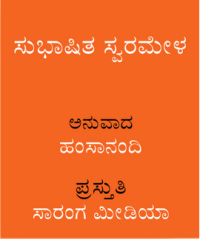Balamukundashtakam is a collection of 8 Samskrta shlokas that describe some episodes from the childhood of Krishna. Although the first of the eight shlokas is found in Bilwamangala’s (also called Leelashuka) work Krishnakarnamrta, the rest of the shokas are not to be found there. I’m not aware if there is a agreement on the authorship of this work. Anyway, the ashTaka is very attractive, to say the least.
Here is the text in dEvanAgari script:
करारविन्देन पदारविन्दं मुखारविन्दे विनिवेशयन्तम् ।
वटस्य पत्रस्य पुटे शयानं बालं मुकुन्दं मनसा स्मरामि ॥१॥
संहृत्य लोकान्वटपत्रमध्ये शयानमाद्यन्तविहीनरूपम् ।
सर्वेश्वरं सर्वहितावतारं बालं मुकुन्दं मनसा स्मरामि ॥२॥
इन्दीवरश्यामलकोमलांगं इन्द्रादिदेवार्चितपादपद्मम् ।
सन्तानकल्पद्रुममाश्रितानां बालं मुकुन्दं मनसा स्मरामि ॥३॥
लम्बालकं लम्बितहारयष्टिं शृंगारलीलांकितदन्तपङ्क्तिम् ।
बिंबाधरं चारुविशालनेत्रं बालं मुकुन्दं मनसा स्मरामि ॥४॥
शिक्ये निधायाद्यपयोदधीनि बहिर्गतायां व्रजनायिकायाम् ।
भुक्त्वा यथेष्टं कपटेन सुप्तं बालं मुकुन्दं मनसा स्मरामि ॥५॥
कलिन्दजान्तस्थितकालियस्य फणाग्ररंगे नटनप्रियन्तम् ।
तत्पुच्छहस्तं शरदिन्दुवक्त्रं बालं मुकुन्दं मनसा स्मरामि ॥६॥
उलूखले बद्धमुदारशौर्यं उत्तुंगयुग्मार्जुन भंगलीलम् ।
उत्फुल्लपद्मायत चारुनेत्रं बालं मुकुन्दं मनसा स्मरामि ॥७॥
आलोक्य मातुर्मुखमादरेण स्तन्यं पिबन्तं सरसीरुहाक्षम् ।
सच्चिन्मयं देवमनन्तरूपं बालं मुकुन्दं मनसा स्मरामि ॥८॥
The shokas are notable for the extra-ordinary lilting quality, that makes even a simple reading of it makes you feel like you’re listening to a song! Such a delicate structure, does not make it an easy target for translation, and it is hard for any translation to make full justice to the original.
Anyway, I had made an attempt to translate this ashTaka into Kannada a while ago. I see a translation as a means for someone who doesn’t understand the original to get some familiarity and exposure. That translation features in my book Hamsanada as well.
Recently I made a renewed attempt to update the translation to follow metrical rules, thanks to Padyapaana – and here is the result. It is set in choupadi meter (4 liners):
ಕೈಯ ತಾವರೆಯಿಂದ ಕಾಲದಾವರೆಯನ್ನು
ಬಾಯ ತಾವರೆಯಲ್ಲಿ ಇರಿಸಿದವನ
ಮಾಯದಾ ಶಿಶು ಆಲದೆಲೆ ಮೇಲೆ ಪವಡಿಸಿದೆ-
ಳೆಯ ಮುಕುಂದನ ನಾನು ನೆನೆವೆನಿಂದು ||೧||
ಜಗಗಳನೆ ಕೊನೆಗೊಳಿಸಿ ಆಲದೆಲೆ ಮೇಗಡೆ ಮ-
ಲಗಿಹಂಥ ಕೊನೆಮೊದಲು ಇಲ್ಲದವನ
ಜಗದೊಡೆಯ ಜನರೆಲ್ಲರೊಳಿತಿಗೈತಂದವನ
ಮಗುಮುಕುಂದನ ನಾನು ನೆನೆವೆ ಮನದಿ ||೨||
ಕನ್ನೈದಿಲೆಯ ನೀಲ ಕೋಮಲಾಂಗದ ಹರಿಯ
ಮುನ್ನ ಇಂದ್ರಾದಿಗಳ ಪೂಜೆವಡೆದ
ಚೆನ್ನಾಗಿ ಆಸರೆಯಲಿಹರನ್ನು ಕಾಯ್ವಂಥ
ಚಿನ್ನ ಕಂದನ ನಾನು ನೆನೆವೆ ಮನದಿ ||೩||
ಮುಂಗುರಳಲೆಸೆಯುವನ ಸರಗಳಲಿ ಮೆರೆಯುವನ
ಸಿಂಗರದಿ ಮೂಡಿರುವ ಸುಲಿಪಲ್ಲ ಚೆಲುವ
ತೊಂಡೆತುಟಿಯಲಿ ಕೊಳಲ ನಾದವನು ತುಂಬಿರುವ
ಚಂದಚನ್ನಿಗ ಮುಕುಂದನ್ನ ನೆನೆವೆ ||೪||
ಚೆಲುವೆ ಗೋಪಿಯರೆಲ್ಲ ಮನೆಹೊರಗೆ ಹೋಗಿರಲು
ನಿಲುವಿನಲಿ ಹಾಲ್ಬೆಣ್ಣೆ ಮೊಸರೆಲ್ಲವನ್ನು
ಸುಳಿವು ಬಿಡದೆಲೆ ತಿಂದು ಕಪಟದಲಿ ಮಲಗಿರುವ
ಖಳನಿವನ ಮುಕುಂದನನೀಗ ನೆನೆವೆ || ೫||
ಕಾಳಿ ಯಮುನೆಯೊಳಗಡಗಿರುತಿದ್ದ ಕಾಳಿಯನ
ಏಳುಹೆಡೆಗಳ ಮೇಲೆ ಕುಣಿಯುತ್ತಲವನ
ಬಾಲವನು ಹಿಡಿದವನ ಚಂದಿರನ ಮೊಗದವನ
ಬಾಲಕನ ಮುಕುಂದನ ನಾನು ನೆನೆವೆ || ೬ ||
ಒರಳುಕಲ್ಲಿಗೆ ಬಿಗಿದು ಕಟ್ಟಿರಲು ಶೌರಿಯಿವ
ಮರವೆರಡನೊಟ್ಟಿಗೇ ಬೀಳಿಸಿಹನ
ಅರಳಿರುವ ಕಮಲ ಹೂದಳದಗಲ ಕಣ್ಣಿರುವ
ಪೋರನಿವ ಮುಕುಂದನ ನಾನು ನೆನೆವೆ ||೭||
ಮೊಲೆಹಾಲ ಕುಡಿಯುತಲಿ ತಾಯಮೊಗದಲ್ಲಿ ಕಂ-
ಡೆಳೆನಗುವ ನೋಡುತಿಹ ಕಮಲಾಕ್ಷನ
ಅಳವಿರದ ಮೊದಲುಕೊನೆಯಿಲ್ಲದಿಹ ಚಿನ್ಮಯನ
ಎಳೆಯನ್ನ ಮುಕುಂದನ ಮನದಿ ನೆನೆವೆ ||೮||
While in the original ashTaka, all the shlokas end with the same pAda – बालं मुकुन्दं मनसा स्मरामि – in the translation they are all changed but in line with the rest of the content of the shloka. Otherwise, I have tried to be follow the original as much as possible.
Your comments & feedback welcome!
-neelanjana
Picture taken from:http://www.wallpapershigh.com/66/janmashtami-wallpaper-and-krishna-janmashtami-wallpaper/krishna-wallpaper-get-together-with-people/




1 comment
Comments feed for this article
ಮೇ 9, 2012 at 5:17 ಅಪರಾಹ್ನ
Sadashiva Bhat
excellent job!! Please keep it up!! I can see a great poet in You Sir
LikeLike